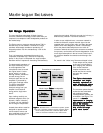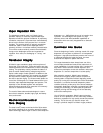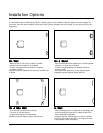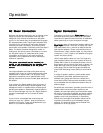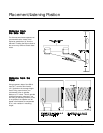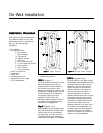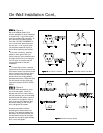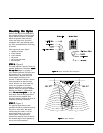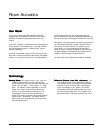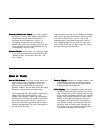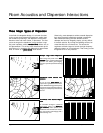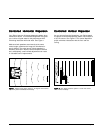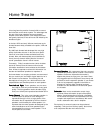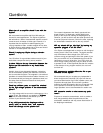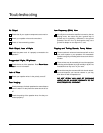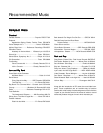
Page 16
Stylos User's Manual
Your RoomYour Room
Your RoomYour Room
Your Room
This is one of those areas that requires both a little
background to understand and some time and experi-
mentation to obtain the best performance from your
system.
Your room is actually a component and an important part
of your system. This component is a very large variable
and can dramatically add to, or subtract from, a great
musical experience.
All sound is composed of waves. Each note has its own
wave size, with the lower bass notes literally encompass-
ing from 10' to as much as 40'! Your room participates in
Room Acoustics
TerminologyTerminology
TerminologyTerminology
Terminology
Standing WavesStanding Waves
Standing WavesStanding Waves
Standing Waves. The parallel walls in your room will
reinforce certain notes to the point that they will
sound louder than the rest of the audio spectrum and
cause “one note bass”, “boomy bass”, or “tubby
bass”. For instance, 100Hz represents a 10' wave-
length. Your room will reinforce that specific fre-
quency if one of the dominant dimensions is 10'.
Large objects in the room such as cabinetry or
furniture can help to minimize this potential problem.
Some serious “audiophiles” will literally build a
special room with no parallel walls just to get away
from this phenomenon.
this wave experience like a 3 dimensional pool with
waves reflecting and becoming enhanced depending on
the size of the room and the types of surfaces in the room.
Remember, your audio system can literally generate all of
the information required to recreate a musical event in
time, space, and tonal balance. The purpose of your
room, ideally, is to not contribute to that information.
However, every room does contribute to the sound and
the better speaker manufacturers have designed their
systems to accommodate this phenomenon.
Let’s talk about a few important terms before we begin.
Reflective Surfaces (near-field reflections)Reflective Surfaces (near-field reflections)
Reflective Surfaces (near-field reflections)Reflective Surfaces (near-field reflections)
Reflective Surfaces (near-field reflections). The
hard surfaces of your room, particularly if close to
your speaker system, will reflect those waves back
into the room over and over again, confusing the
clarity and imaging of your system. The smaller
sound waves are mostly effected here and occur in
the mid and high frequencies. This is where voice
and frequencies as high as the cymbals can occur.



